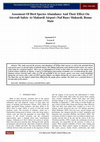Papers by Hangeior Stephen Iorlumun

International Journal of Scientific Research in Multidisciplinary Studies, 2024
Urbanization is rapidly altering ecosystems worldwide, presenting both challenges and opportuniti... more Urbanization is rapidly altering ecosystems worldwide, presenting both challenges and opportunities for biodiversity conservation. Birds of prey, as top predators and indicators of environmental health, are particularly sensitive to anthropogenic disturbances. This study investigates Urbanization and its impact on birds of prey in the Makurdi metropolis of Benue State, Nigeria, across several categories of land usage. The Timed Species Count technique was applied across various urban land-use types, including Highways, Residential areas, Tertiary institutions, Commercial centers, and the Airport. Diversity among avian species was assessed by means of the Shannon Diversity Index, Simpson's Index, Gini-Simpson Diversity Index, and Pielou's Evenness Index. Results indicate the occurrence of various, raptor species including the Lizard Buzzard, Black Kite, Marsh Harrier, African Goshawk, and Pearl Spotted Owlet. The Black Kite was the most abundant species, with the airport exhibiting the highest abundance of birds of prey. Infrastructure such as masts, electric poles, and rooftops were utilized by these birds for perching while tree species were used for nesting. Diversity indices varied across different land-use types, suggesting habitatspecific preferences among bird of prey species. It highlights the adaptability of some bird of prey species to urban environments, likely due to the availability of resources and nesting habitats. Although urbanization poses threats to biodiversity, birds of prey create new habitats within urban landscapes, contributing to their resilience. Understanding species habitat behavior is crucial for effective habitat management, conservation, and ecosystem preservation in the face of environmental changes. Urbanization influences the spatial arrangement and population size of raptors, with some species thriving in urban environments. The study underscores the importance of green spaces and noise levels in urban areas for avian diversity. Recommendations include the conservation of green areas and the implementation of measures to mitigate anthropogenic impacts on bird of prey populations.

Birds in their diversity constitute part of the natural environment and play functional role such... more Birds in their diversity constitute part of the natural environment and play functional role such as agents of flower pollination and seed dispersal, sources of food chain and agents in breaking seed dormancy (Nason, 1992). Birds are highly specialized flying machines, and their ability to fly allows them to range widely in search of food and escape predators easily. The invention of airplanes, which was a fundamental turning point in history, came into being about a century years ago from the principles of avian flight. The success of the aircraft invention and the consequent improvements upon it brought about more technological changes. (Oduntan.et.al 2012). Before the advent of aircraft, birds, bats and insects used the skies. Sharing the skies and the environment with aircraft has often times resulted in collision of aircrafts, wildlife and birds. The main problem being the collision between birds and aircraft or the ingestion of birds into the engines of the aircraft, this phenomenon is widely known as Bird strike. Bird strike has posed threat ranging from cracked windshields, dented wind edges and minor fuselage damage to air crashes, since the first ever reported birdstrike on September 7, 1905 when an Orville Wright ran into a flock of birds while flying near Dayton, Ohio. Between 1960 and 2004, bird strikes have resulted in at least 333 military aircraft destroyed and over 150 military personnel killed (Shobakin, 2009). Over the years, aircraft designs and performance has changed radically as birds" population and migration have increased (Dolbeer and Seubert, 2009). The occurrence of birds at airports varies according to habitat type, weather and the time of the day and the season of the year (Weisbein and Shy, 1999). Usually, the combination of several attractants, are responsible for the presence of birds at an airport. These include availability of food, water, loafing and breeding sites. Many airports support an abundance of food like seeds, grasses, shrubs, berries, earthworms and small
Uploads
Papers by Hangeior Stephen Iorlumun